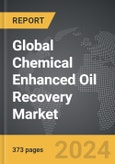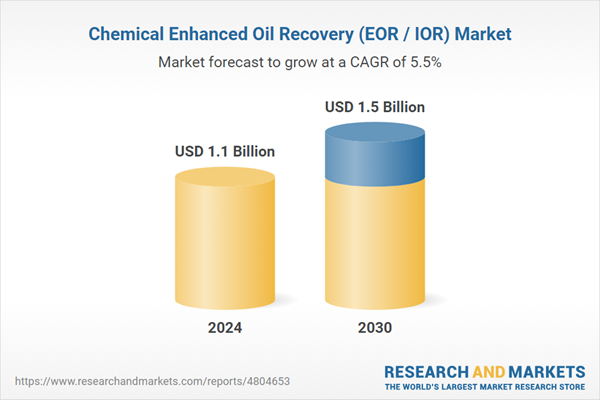The global market for Chemical Enhanced Oil Recovery (EOR / IOR) was valued at US$1.1 Billion in 2024 and is projected to reach US$1.5 Billion by 2030, growing at a CAGR of 5.5% from 2024 to 2030. This comprehensive report provides an in-depth analysis of market trends, drivers, and forecasts, helping you make informed business decisions. The report includes the most recent global tariff developments and how they impact the Chemical Enhanced Oil Recovery (EOR / IOR) market.
Technological advancements have significantly improved the effectiveness and economic viability of chemical EOR. Innovations in chemical formulations have led to the development of more efficient and environmentally friendly chemicals, such as smart polymers and green surfactants. These advancements have enhanced the performance of chemical EOR processes, allowing for better customization to specific reservoir conditions and reducing the overall cost. Additionally, advancements in reservoir characterization and simulation technologies have enabled more accurate predictions of EOR performance, optimizing the design and implementation of chemical EOR projects. The integration of real-time monitoring and advanced data analytics has further improved the management and control of EOR operations, ensuring optimal recovery rates and minimizing environmental impact. These technological improvements have expanded the application of chemical EOR, making it a more attractive option for operators seeking to maximize the output of mature oil fields.
The growth in the chemical EOR market is driven by several factors. The increasing global demand for energy and the depletion of easily accessible oil reserves have heightened the need for advanced recovery techniques to sustain oil production levels. The rise in oil prices has also made chemical EOR more economically feasible, encouraging investments in EOR projects. Technological advancements, such as the development of more effective and cost-efficient chemicals, have further driven the adoption of chemical EOR methods. Additionally, the focus on reducing carbon emissions and enhancing the sustainability of oil recovery processes has led to the development of greener EOR technologies, which are gaining regulatory and public support. Government incentives and favorable policies aimed at extending the life of mature oil fields and improving energy security are also significant drivers. These factors, coupled with the continuous innovation in EOR technologies and the growing need for enhanced oil recovery solutions, are propelling the growth of the chemical EOR market, ensuring its critical role in the future of global oil production.
Segments: Type (Polymer Flooding, Alkaline-Surfactant-Polymer Flooding, Surfactant-Polymer Flooding, and Other Types); and Segment (Petro-based, and Bio-based).
Geographic Regions/Countries: World; USA; Canada; China; Europe; UK; Russia; Kazakhstan; Norway; Rest of Europe; Asia-Pacific; Middle East; Rest of World.
The analysts continuously track trade developments worldwide, drawing insights from leading global economists and over 200 industry and policy institutions, including think tanks, trade organizations, and national economic advisory bodies. This intelligence is integrated into forecasting models to provide timely, data-driven analysis of emerging risks and opportunities.
Abstract:
Global Chemical Enhanced Oil Recovery (EOR / IOR) Market to Reach US$1.5 Billion by 2030
The global market for Chemical Enhanced Oil Recovery (EOR / IOR) estimated at US$1.1 Billion in the year 2024, is expected to reach US$1.5 Billion by 2030, growing at a CAGR of 5.5% over the analysis period 2024-2030. Polymer Flooding, one of the segments analyzed in the report, is expected to record a 5.8% CAGR and reach US$856.5 Million by the end of the analysis period. Growth in the Alkaline-Surfactant-Polymer Flooding segment is estimated at 5.3% CAGR over the analysis period.Global Chemical Enhanced Oil Recovery (EOR / IOR) Market - Key Trends & Drivers Summarized
Chemical Enhanced Oil Recovery (EOR) or Improved Oil Recovery (IOR) is an advanced method used to increase the extraction of oil from mature or depleted reservoirs. This technique involves injecting chemicals, such as polymers, surfactants, and alkali agents, into the oil reservoir to alter the properties of the oil and rock, improving oil mobility and increasing the efficiency of the recovery process. Chemical EOR methods work by reducing the interfacial tension between the oil and water, altering the wettability of the reservoir rocks, and improving the viscosity of the displacing fluid. These changes enhance the displacement of trapped oil, enabling the extraction of additional volumes that would otherwise be left behind using conventional methods. The application of chemical EOR has been particularly successful in challenging reservoirs, including those with heavy or viscous oils, low permeability, or heterogeneous rock formations.Technological advancements have significantly improved the effectiveness and economic viability of chemical EOR. Innovations in chemical formulations have led to the development of more efficient and environmentally friendly chemicals, such as smart polymers and green surfactants. These advancements have enhanced the performance of chemical EOR processes, allowing for better customization to specific reservoir conditions and reducing the overall cost. Additionally, advancements in reservoir characterization and simulation technologies have enabled more accurate predictions of EOR performance, optimizing the design and implementation of chemical EOR projects. The integration of real-time monitoring and advanced data analytics has further improved the management and control of EOR operations, ensuring optimal recovery rates and minimizing environmental impact. These technological improvements have expanded the application of chemical EOR, making it a more attractive option for operators seeking to maximize the output of mature oil fields.
The growth in the chemical EOR market is driven by several factors. The increasing global demand for energy and the depletion of easily accessible oil reserves have heightened the need for advanced recovery techniques to sustain oil production levels. The rise in oil prices has also made chemical EOR more economically feasible, encouraging investments in EOR projects. Technological advancements, such as the development of more effective and cost-efficient chemicals, have further driven the adoption of chemical EOR methods. Additionally, the focus on reducing carbon emissions and enhancing the sustainability of oil recovery processes has led to the development of greener EOR technologies, which are gaining regulatory and public support. Government incentives and favorable policies aimed at extending the life of mature oil fields and improving energy security are also significant drivers. These factors, coupled with the continuous innovation in EOR technologies and the growing need for enhanced oil recovery solutions, are propelling the growth of the chemical EOR market, ensuring its critical role in the future of global oil production.
Report Scope
The report analyzes the Chemical Enhanced Oil Recovery (EOR / IOR) market, presented in terms of units. The analysis covers the key segments and geographic regions outlined below.Segments: Type (Polymer Flooding, Alkaline-Surfactant-Polymer Flooding, Surfactant-Polymer Flooding, and Other Types); and Segment (Petro-based, and Bio-based).
Geographic Regions/Countries: World; USA; Canada; China; Europe; UK; Russia; Kazakhstan; Norway; Rest of Europe; Asia-Pacific; Middle East; Rest of World.
Key Insights:
- Market Growth: Understand the significant growth trajectory of the Polymer Flooding segment, which is expected to reach US$856.5 Million by 2030 with a CAGR of a 5.8%. The Alkaline-Surfactant-Polymer Flooding segment is also set to grow at 5.3% CAGR over the analysis period.
Why You Should Buy This Report:
- Detailed Market Analysis: Access a thorough analysis of the Global Chemical Enhanced Oil Recovery (EOR / IOR) Market, covering all major geographic regions and market segments.
- Competitive Insights: Get an overview of the competitive landscape, including the market presence of major players across different geographies.
- Future Trends and Drivers: Understand the key trends and drivers shaping the future of the Global Chemical Enhanced Oil Recovery (EOR / IOR) Market.
- Actionable Insights: Benefit from actionable insights that can help you identify new revenue opportunities and make strategic business decisions.
Key Questions Answered:
- How is the Global Chemical Enhanced Oil Recovery (EOR / IOR) Market expected to evolve by 2030?
- What are the main drivers and restraints affecting the market?
- Which market segments will grow the most over the forecast period?
- How will market shares for different regions and segments change by 2030?
- Who are the leading players in the market, and what are their prospects?
Report Features:
- Comprehensive Market Data: Independent analysis of annual sales and market forecasts in US$ Million from 2024 to 2030.
- In-Depth Regional Analysis: Detailed insights into key markets, including the U.S., China, Japan, Canada, Europe, Asia-Pacific, Latin America, Middle East, and Africa.
- Company Profiles: Coverage of players such as BASF SE, Dow Inc., Cargill, Inc., Chevron Corporation, BP PLC and more.
- Complimentary Updates: Receive free report updates for one year to keep you informed of the latest market developments.
Some of the 69 companies featured in this Chemical Enhanced Oil Recovery (EOR / IOR) market report include:
- BASF SE
- Dow Inc.
- Cargill, Inc.
- Chevron Corporation
- BP PLC
- Ecolab, Inc.
- Baker Hughes Company
- ChampionX
- Clariant AG
- Canadian Natural Resources Ltd.
- Chemiphase Ltd.
- Beijing Hengju Chemical Group Corporation
- Cenovus Energy, Inc.
- Exterran Corporation
- ChemEOR, Inc.
Tariff Impact Analysis: Key Insights for 2025
Global tariff negotiations across 180+ countries are reshaping supply chains, costs, and competitiveness. This report reflects the latest developments as of April 2025 and incorporates forward-looking insights into the market outlook.The analysts continuously track trade developments worldwide, drawing insights from leading global economists and over 200 industry and policy institutions, including think tanks, trade organizations, and national economic advisory bodies. This intelligence is integrated into forecasting models to provide timely, data-driven analysis of emerging risks and opportunities.
What’s Included in This Edition:
- Tariff-adjusted market forecasts by region and segment
- Analysis of cost and supply chain implications by sourcing and trade exposure
- Strategic insights into geographic shifts
Buyers receive a free July 2025 update with:
- Finalized tariff impacts and new trade agreement effects
- Updated projections reflecting global sourcing and cost shifts
- Expanded country-specific coverage across the industry
Table of Contents
I. METHODOLOGYII. EXECUTIVE SUMMARY2. FOCUS ON SELECT PLAYERSIII. MARKET ANALYSISIV. COMPETITION
1. MARKET OVERVIEW
3. MARKET TRENDS & DRIVERS
4. GLOBAL MARKET PERSPECTIVE
UNITED STATES
CANADA
CHINA
EUROPE
UNITED KINGDOM
RUSSIA
KAZAKHSTAN
NORWAY
REST OF EUROPE
ASIA-PACIFIC
MIDDLE EAST
REST OF WORLD
Companies Mentioned (Partial List)
A selection of companies mentioned in this report includes, but is not limited to:
- BASF SE
- Dow Inc.
- Cargill, Inc.
- Chevron Corporation
- BP PLC
- Ecolab, Inc.
- Baker Hughes Company
- ChampionX
- Clariant AG
- Canadian Natural Resources Ltd.
- Chemiphase Ltd.
- Beijing Hengju Chemical Group Corporation
- Cenovus Energy, Inc.
- Exterran Corporation
- ChemEOR, Inc.
Table Information
| Report Attribute | Details |
|---|---|
| No. of Pages | 373 |
| Published | April 2025 |
| Forecast Period | 2024 - 2030 |
| Estimated Market Value ( USD | $ 1.1 Billion |
| Forecasted Market Value ( USD | $ 1.5 Billion |
| Compound Annual Growth Rate | 5.5% |
| Regions Covered | Global |









